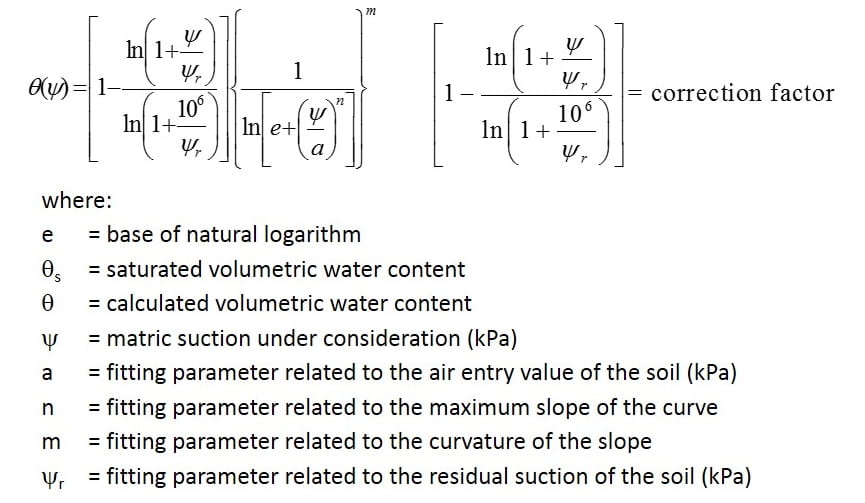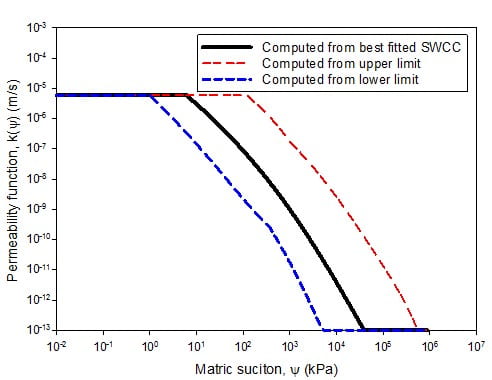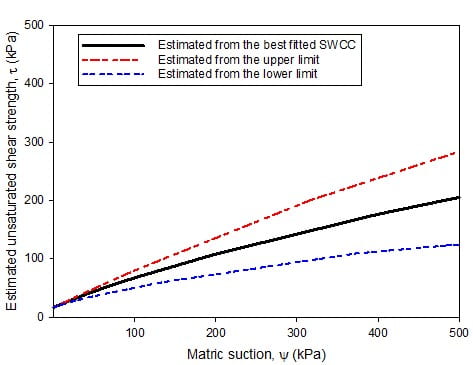Equation for SWCC
The equation for fitting the SWCC is required for the following advantages: the SWCC can be modelled as a continuous function, the SWCC variables can be determined from the fitting parameters, the duration of SWCC tests can be shortened to minimize the cost of SWCC tests and the fitting parameters can be used to estimate the permeability function of soil.
Equation for best fitting unimodal SWCC, Fredlund and Xing 1994

Equation for best fitting unimodal SWCC, Fredlund and Xing 1994
Leong and Rahardjo (1997) recommended to use a correction factor C(ψ) = 1 in the Fredlund and Xing (1994) equation for fitting the SWCC with residual matric suction less than 1500 kPa. This would reduce the computation effort in determining the SWCC fitting parameter and result in the better performance of SWCC equation in fitting unimodal SWCC.

Fredlund and Xing (1994) equation with correction factor = 1, Leong and Rahardjo 1997
Equation for best fitting bimodal SWCC, Satyanaga et al 2013

Equation for best fitting bimodal SWCC, Satyanaga et al 2013
Determination of SWCC variables Zhai and Rahardjo 2012
Zhai and Rahardjo (2012) developed equations for determination of SWCC variables from Fredlund and Xing (1994) fitting parameters.

Determination of SWCC variables Zhai and Rahardjo 2012
Determination of the confidence limits of SWCC, Zhai and Rahardjo 2013
Study by Zhai and Rahardjo (2013) indicated that the confidence limits of SWCC can be estimated from the residual error obtained in the regression analyses.

Illustration of the confidence limits of SWCC, Zhai and Rahardjo 2013
Permeability function of soil estimated from confidence limits of SWCC, Zhai et al 2016
For design purpose, Zhai et al 2016 suggested that upper confidence limit of SWCC should be used for infiltration analyses while the lower confidence limit of SWCC should be used for estimation of the shear strength.
 Permeability function of soil estimated from confidence limits of SWCC, Zhai et al 2016
Permeability function of soil estimated from confidence limits of SWCC, Zhai et al 2016
References
- Zhai, Q., Rahardjo, H., and Satyanaga, A. (2016). “Variability in unsaturated hydraulic properties of residual soil in Singapore.” Engineering Geology, 209, 21-29. doi
- Satyanaga, A., Rahardjo, H., Leong, E. C. and Wang, J. Y. (2013). “Water characteristic curve of soil with bimodal grain-size distribution.” Computer and Geotechnics, January, 48, 51-61. doi | handle
- Zhai, Q. and Rahardjo, H. (2013). “Quantification of uncertainties in soil–water characteristic curve associated with fitting parameters.” Engineering Geology, June, 163, 144-152. doi
- Zhai, Q. and Rahardjo, H. (2012). “Determination of soil-water characteristic curve variables.” Computers and Geotechnics, May, 42, 37-43. doi | handle
- Leong, E. C. and Rahardjo, H. (1997). “Review of soil-water characteristic curve equations.” Journal of Geotechnical and Geoenvironmental Engineering, December, 123(12), 1106-1117. doi | handle
- Fredlund, D. G., and Xing, A. (1994). “Equations for the soil-water characteristic curve.” Canadian Geotechnical Journal, 31(4), 521-532. doi
